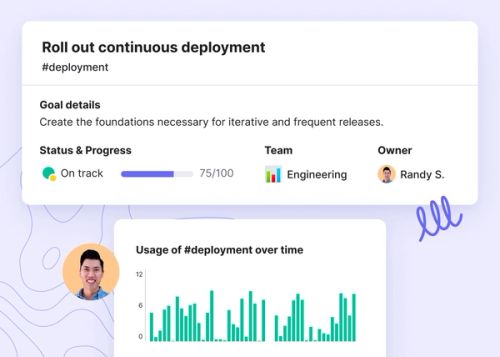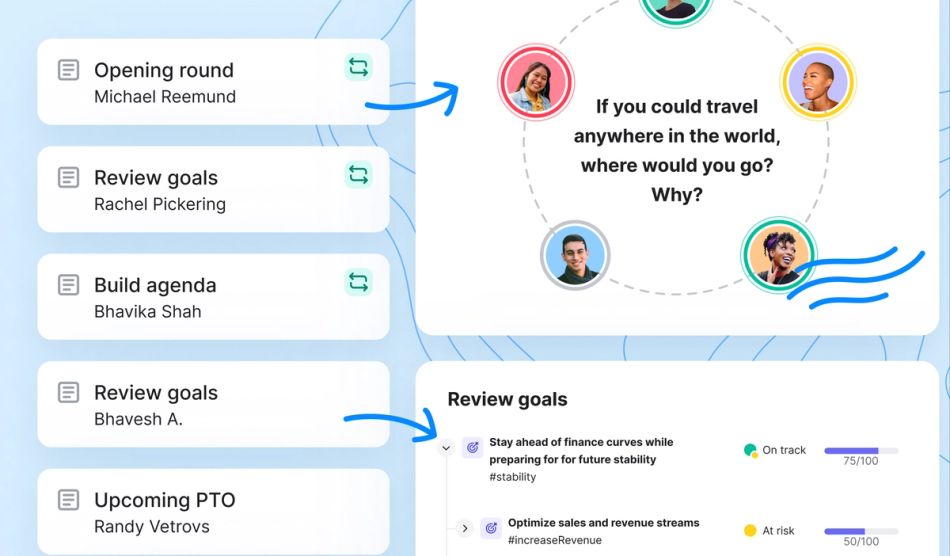
We all want to work within a healthy, positive team culture. Whether you’re a developer-heavy workforce or focused on customer success, the health of your internal teams will always spill out into the work itself — as well as any customer or client interactions.
Every organization can grow and improve in this crucial area.
Most leaders have a general sense of the culture, but getting specific is harder. Many struggle with both how to measure team culture and what steps to take to improve it.
Today’s article helps with both. We’ll show you 5 key characteristics of strong team cultures and give you a step-by-step guide to get there.
What makes a great work culture?
So, what exactly makes a workplace culture strong and healthy? And on the other side of the coin, what characteristics reveal an unhealthy work culture when they’re missing?
The following five characteristics are a good start. No matter your industry or size, striving for these characteristics will move you in a healthier direction, helping with teamwork, positivity, retention, better mentoring, and more.
Team communication is open, honest, friendly, and productive
One of the clearest signs of a great work culture is frequent communication that’s consistently open, honest, friendly, and productive.
Although poor communication is one of the most frequent complaints in business, communication alone isn’t a holistic solution. Getting the visibly angry guy to talk more is a start, but it isn’t the end goal — resolving the anger is (preferably without involving human resources).
Healthy teams tend to communicate more frequently, and that communication is itself healthier.
If you have team members struggling to find ways to communicate clearly, kindly, and in productive ways, the WINFY (What I Need From You) structure can be a powerful tool for remote or hybrid work settings.
2. Team members trust one another and their managers
Healthy team cultures involve high levels of trust, both on the peer level and the manager-to-team member level.
When team members feel cared for and supported (again, on both the peer and the manager level), and when they consistently get what they need (including clear communication) from those parties, it builds trust.
Trust takes time, of course. And building trust can be more challenging when team members don’t physically interact with one another in a shared space, as is the case in remote or hybrid environments.
It’s also helpful to remember that teams usually progress through four predictable phases (forming, storming, norming, and performing) of trust and culture bulidng.
Trust levels naturally vary through this progression, even in healthy cultures. The difference is where your “trust baseline” sits: The higher that baseline, the healthier the team.
3. Work is team-oriented
Does everyone on your team work towards a shared goal?
Great work cultures aren’t highly competitive on an individualistic level. Instead, they orient work around a team, with multiple skilled contributors working toward a common goal.

Set up Team Goals in Range
- Create accountability by sharing information and updates across the team
- Easily track how daily work connects to higher-level goals
- Set a goal for metrics, objectives, and KPIs
- With hashtags, see all artifacts, updates, and day-to-day progress in one place
- Share goal updates with leaders via Slack or email
There are certain functions (sales in certain industries, for one) where there’s no avoiding a competitive culture.
But even at intensely competitive and individualistic businesses (car dealerships come to mind), leaders can take steps to encourage team goals, not just individual ones.
4. Team members share knowledge freely
Siloing is one persistent enemy throughout the modern workplace. When information, knowledge, or work gets siloed, one group (department, team, or even an individual contributor) keeps that information locked in their silo. Other teams either don’t know about it, can’t access it, or must request access from gatekeepers.
Our tech-driven and increasingly remote world inherently generates information silos. Unhealthy cultures build their own, too.
In contrast, healthy cultures work to break down naturally occurring silos, and they share knowledge freely instead.
5. Help is given and received by team members whenever needed
How do team members at your business feel when they need to ask for help? Do you operate in an environment where questions are welcome opportunities for learning and coaching, or is asking for help seen as a sign of weakness?
Healthy work cultures are environments where questions are welcomed — not punished or belittled.
Your step-by-step guide for creating a great team culture
If your team culture isn’t quite fulfilling these characteristics, then it’s time to start working toward improving it. Below is our step-by-step guide to help guide teams into better habits. Execute these six steps, and you’ll propel your company forward toward a happier, healthier team dynamic and a stronger team culture.
1. Create company values using everyone's input
First, if you’ve never put your company values to paper, now’s the time to do so. And if you’ve already formulated your values, consider whether it’s time to reevaluate them.
Here’s the crucial step that many organizations miss: Involve your team or broader organization in the process.
Too many employees don’t know (or remember) their company values. They may have seen them in a slide deck during their orientation, but who remembers much from their first day?
When you involve team members — solicit their input and incorporate what works into the company or team values — you’ll gain buy-in and begin moving toward a healthier company culture.
This first step is especially crucial if you’re changing the work environment. For example, bringing some team members (or all of them) back to the office, or transitioning to a more long-term hybrid approach.
2. Establish what it means to be a “team player” at your company
Next, apply those company values to a real-world question: What does a team player look like at your company or on your team?
Let’s say one of your company values is to be a market leader in your space. Get your team members thinking through what a team player would do to contribute toward that value or goal. Would they hoard information? Engage in self-promotion at the expense of teammates? Or would they willingly share whatever tactics have made them successful?
Scale this exercise across all departments and roles, and you’ll soon have a robust collection of tangible ways to work toward a healthier company.
3. Build goals, milestones, and objectives around your values
Next up is ensuring that every milestone, goal, and objective you create has a solid foundation in your company values.
As companies grow and mature, they tend to face greater complexity. Scaling existing processes and services adds complexity on its own, and any new products or service areas do so at an even greater pace. Before long, it’s easy for businesses to lose focus on those company values from step one.
Healthy teams understand why they’re doing what they’re doing. They can draw a straight line from their tasks or broader projects to specific company values.
When you find objectives or goals that don’t support company values, you find a problem: You either have a darling to kill, or you haven’t created robust enough company values.
4. Define roles and clarify how team members work together
Confusion or lack of clarity surrounding roles is another clear sign of poor organizational health. All sorts of problems set in when team members don’t understand how they are intended to work together or how various roles interact:
- They don’t communicate clearly and openly.
- They can’t build trust and constantly feel let down by other team members (who themselves may not know anything’s gone wrong).
- They struggle to work toward shared goals and can’t get clarity on shared responsibilities.
- They don’t share knowledge freely or with the right people.
- They don’t know who to ask for help when they need it
Do any of these sound familiar? They are the opposite of the five characteristics of positive team culture we discussed earlier!
Work as hard as you can to create clearly defined roles and document this information so that any team member can find it if needed. Only once this clarity exists throughout your organization will you start building a healthier culture.
5. Use trust-building strategies to connect your team
Healthy teams will naturally build some level of trust, but you can enhance or speed up this process by using strategic trust-building activities.
The days of corporate retreats in the woods are pretty much gone, and creating effective, non-cringeworthy virtual versions is a challenge. But it can be done — even simple icebreaker-style games at the beginning of team meetings can build small amounts of trust among group members through problem-solving, social interaction, and more. Compound this over time, and the results add up.
6. Have fun as a team!
Last, healthy teams enjoy each other and can easily have fun together. One way to help foster that feeling of camaraderie is to actually schedule fun events as a team.
Yes, a half-day “fun” event is a hit to productivity. But in the long run, the bigger productivity hit is working on a toxic, unhealthy team.
Building team culture through fun initiatives and icebreakers are worth the effort and the time.
- Drawing games — From competitive, team-based games like Draw Battle to collaborative games like Gartic Phone, drawing games are one of the best ways to create moments of fun and connection on your team. Laughter isn’t just a powerful stress reliever – it’s also a great way to foster team connectedness, especially on remote teams, where spontaneous casual interactions are harder to come by.
- Gatheround — Gatheround turns video meetings into fun online gatherings. The video platform pairs off mentors and mentees, tees up prompt cards for interesting conversations that go beyond the boundaries of the everyday grind, and provides pre-made templates for monthly leadership meetings, socials, and more.
- Range — Range integrates team building into the daily flow of work, helping teams stay in sync about what they’re working on and how they’re doing.
- Offer brown bag sessions to discuss important topics and ideas (even virtually)
What are the different types of corporate culture?
Healthy companies don’t all look the same. Most corporate cultures fit into one of four categories, and you’ll find healthy work cultures in all four categories. What works well for one company may not be the right choice for yours.
Here’s a quick overview of these four corporate cultures as defined by Elliott Jaques way back in 1951, plus pros and cons for each.
Type 1: Clan culture
Clan culture focuses on the team as a tribe or clan, a close-knit group of people tied together in a unique way. You see clan culture in many startups and small businesses along with family-run businesses. Clan culture doesn’t love formal, distance-creating structures and prefers a direct, happy model of interaction.
With clan culture, all teammates are like one big, happy family that works well together, communicates intuitively, and accomplishes a lot.
Pros
- Family atmosphere creates tightly bonded teams
- No silos here
- Can be fast-moving and agile, without bloated structures to bog it down
Cons
- Doesn’t scale well: Growth requires structure and strong decision-making
- Families fight without a hierarchy or authority: Peer personalities can clash
- Fear of disagreeing: Group mentality makes speaking out more difficult
Type 2: Adhocracy culture
Adhocracy takes the flexible, low-structure approach of clan culture but removes the clan component, focusing instead on achievement (usually individual achievement), risk-taking, and innovation. Many tech companies take the adhocracy approach, where “fail fast” is a common mantra and innovation is practically a religion.
Pros
- Moves fast and flexibly
- Egalitarian approach rewards good ideas from anyone, regardless of rank
- Usually creates high levels of employee engagement
Cons
- Can lead to unhealthy individual competition and infighting
- High-stakes risks don’t always pan out, which can damage or even destroy a business
Type 3: Market culture
Market culture focuses on results. This culture is common in established businesses where flexibility isn’t as common. Successful companies don’t happen by accident, so the structure and strategy that got them this far is worth maintaining.
In market culture, there’s constant talk of targets, deadlines, results, and performance. This culture has a shared focus on individual and team performance, both in service of more and more results.
Pros
- Results-focused
- Support for professional development is common (better employees, better results)
- Team members usually enjoy rallying to a cause and celebrating big wins
Cons
- Constant push for results runs the risk of burnout
- Employees may feel like cogs in a machine, not whole people
- Failing to achieve results can destroy morale and team culture
Type 4: Hierarchy culture
Hierarchy culture is the most formal and traditional style, with an org chart that can be clearly laid out with a very powerful person at the top. Chain of command, working your way up the corporate ladder, and formal reporting structures are all common here.
Pros
- Most likely to have clearly defined roles and responsibilities
- Policies and procedures are well documented
- Clear chain of command for decision-making
Cons
- Prone to bloat (layers upon layers of management)
- Tends to be extremely rigid and full of red tape
- Doesn’t support creativity or outside-the-box thinking
Build a fun, efficient, and collaborative team culture with Range
Great leaders and high-performing teams always seem to enjoy good team culture, but this isn’t as automatic as it seems.
An effective team culture doesn’t happen by accident. It takes effort and intentionality to build a strong team marked by cohesion — not to mention the right set of tools.

Remote and hybrid teams deal with additional complexities created by distance.
Range can help: Our powerful platform for asynchronous check-ins keeps teams and managers plugged in and connected, no matter the distance.








